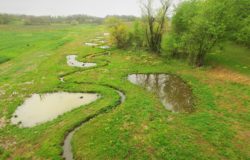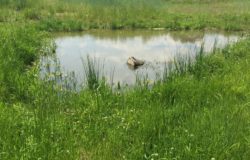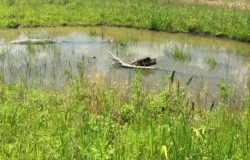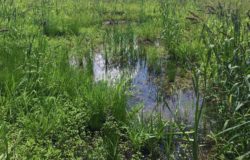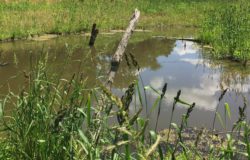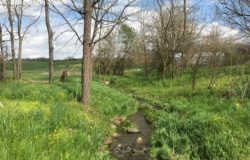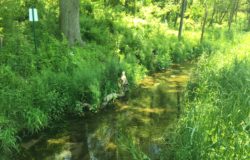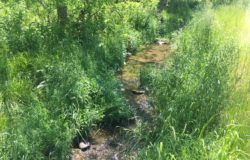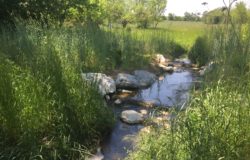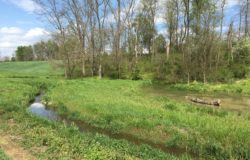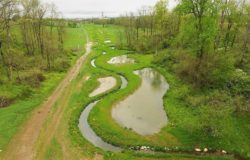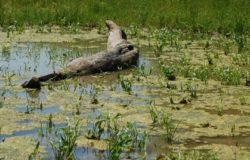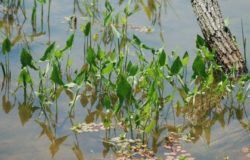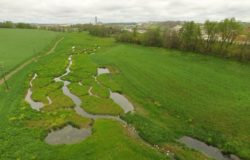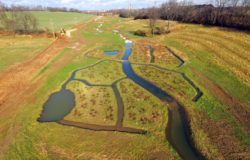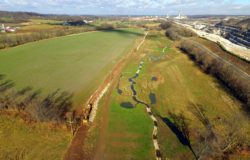Haines Branch
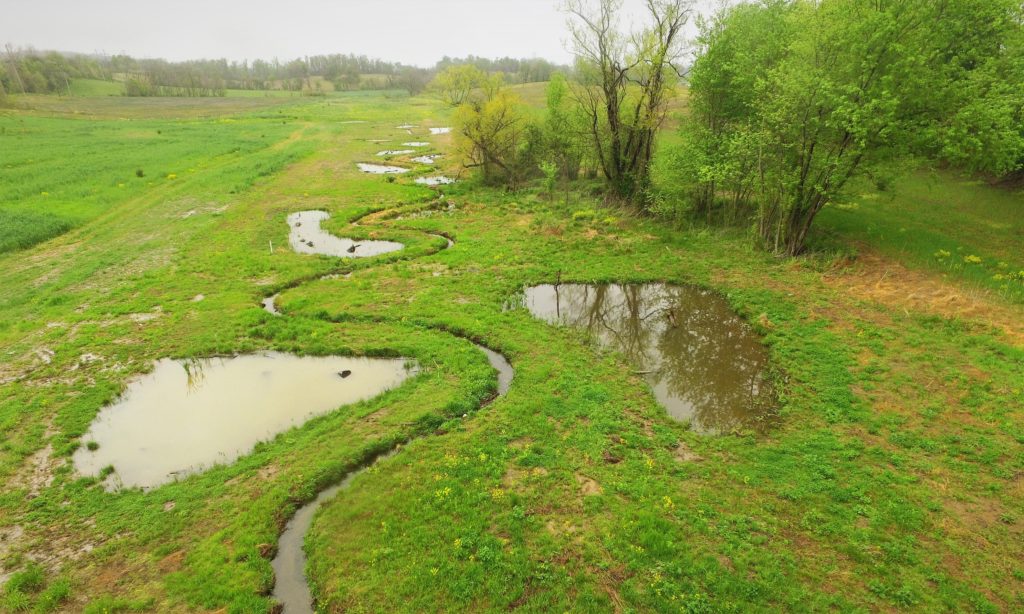
Haines Branch Mitigation: Stream & Ecological Restoration
Union Bridge, MD
Lehigh Cement Company LLC
Haines Branch is located in Frederick County near Union Bridge, Maryland. Haines Branch and its tributaries are first and second order tributaries to Little Pipe Creek in the Monocacy River Basin. This region is situated along the western edge of the Piedmont physiographic province. The total watershed area at the downstream end of the project is 1.82 square miles (1,165.5 acres).
The expansion of the Lehigh Cement Company’s New Windsor Quarry impacted non-tidal wetlands and streams in the Five Daughters Run and Dickenson Run watersheds in Carroll County, Maryland. Five Daughters Run and Dickenson Run are first and third order tributaries to Little Pipe Creek in the Monocacy River Basin. The USACOE required wetland/stream mitigation for the wetland and stream impacts along Five Daughters Run and Dickenson Run. Nearby Haines Branch was identified as a priority restoration site due to its proximity to Five Daughters Run and Lehigh’s ownership of most of the valley.
Phase 1 – Assessment and Phase II Mitigation Plans
Clear Creeks Consulting teamed with Envirens, Inc. and BayLand Consultants and Designers, Inc. to conduct an assessment of the existing conditions along 11,000 LF of Haines Branch and 2100 LF of tributaries, develop Phase II Mitigation Plans and obtain federal and state approvals. Mr. Powell served as Senior Scientist and Restoration Designer. Mr. Jeffrey Wolinski was subcontracted by Clear Creeks to conduct biological surveys.
Technical Services
- Coordination with Envirens, BayLand, CLSI, Lehigh Cement Company, MDE, MDDNR and USACE review staff, and adjacent landowners.
- Field Reconnaissance of stream reaches upstream of the project area
- Geomorphic Assessment
- Geomorphic Mapping
- Stream Morphologic and Channel Stability Assessments
- In-Stream Habitat Evaluations
- Biological Surveys of the fish and macroinvertebrate communities
- Water Quality Monitoring
- Geotechnical Analysis of Soil Conditions along Project Area
- Review and Evaluation of Groundwater Monitoring Data
- Developing Preliminary Design Criteria
- Preparing Findings and Mitigation Design Report
- Preparing Phase II Mitigation Plans
Phase 2 – Final Design and Construction Documents
Clear Creeks Consulting teamed with BayLand Designers and Consultants, Inc. and Envirens, Inc. to develop Final Restoration Design Plans. Mr. Powell served as Senior Scientist and Restoration Designer. Clear Creeks subcontracted Foothills Consulting and Big Eagle Surveying to provide topographic surveying services.
Technical Services:
- Coordination with BayLand, Envirens, Lehigh Cement Company, and adjacent landowners.
- Preparing Final Design Plans
- Preparing Erosion and Sediment Control Plans
- Obtaining Local Grading and E&S Permits
- Preparing Construction Quantities and Cost Estimates
- Preparing Construction Specifications and Construction Bid Documents
Phase 3 – Construction Management
Clear Creeks Consulting teamed with BayLand Designers and Consultants, Inc. and Envirens, Inc. to provide construction management services for the implementation of the Final Design Plans. Mr. Powell served as Senior Construction Manager.
Technical Services:
- Coordinated with BayLand, Envirens, Lehigh Cement Company and Meadville Land Services
- Attended Pre-Bid Meeting with Bidding Contractors
- Attended Pre-Construction Meetings
- Prepared Response to Contractor RFIs
- Provided Routine On-Site Construction Supervision
- Conducted Final Inspection with BayLand, Envirens, Lehigh Cement Company and Meadville Land Services
Project Objectives
Haines Branch and its tributaries had been historically impacted by agricultural activities. The channels in the headwater areas had been straightened and channelized. Clearing of riparian vegetation and unrestricted livestock grazing had resulted in a general lack of riparian buffers and trampled and unstable banks along most reaches. The conversion of land cover from forest to cropland and pasture altered the hydrologic and sediment regimes of the watershed. In the headwater areas baseflow has been reduced. Sediment eroded from cropland along the slopes and from impacted stream reaches had increased the sediment load being transported to downstream reaches within the watershed where deposition initiated lateral adjustments and further instability. The loss of riparian vegetation, decreased baseflow, increased nutrient and sediment loads, as well as channel adjustments, (e.g. down-cutting, widening, and lateral erosion) had impacted water quality and in-stream habitat for fish and macroinvertebrates.
Lehigh Cement was committed to implementing a holistic approach to the restoration of the Haines Branch ecosystem. This approach included the restoration of Haines Branch and its tributaries, floodplain, wetlands, and the adjacent hillslopes draining to the creek within the boundaries of their property.
Design Components
Mitigation/Restoration Site – 52 acres
Mainstem
- 8,995 LF of single thread channels including E4, C4, B3/B2, B4, B4c stream type depending on valley slope
- 10,885 LF of anastomosed channel systems with islands including valley wide floodplain embankments to flatten slope through anastomosed cells
- 8.18 acres of palustrine emergent, scrub-shrub wetlands
- Nine (9) groundwater-intercept dams to augment wetland hydrology
Tributaries
- 1,730 LF of single thread channels including E4, B3/B2, B4 stream type depending on valley slope
Riparian Buffer Zones
- Stream Bank, Wetland and Floodplain Areas – 19.9 acres of Cool Season Grasses, Trees and Shrubs
- Terraces and Adjacent Slopes – 36.6 acres of Warm Season Grasses, Trees and Shrubs
In-Stream Structures and Bank Stabilization Measures
Constructed Riffles, Boulder-Cobble Cascades, Log-Boulder Step-Pools, Log-Cobble Grade Control, Log-Boulder J-Hooks, Toe Wood, Soil Lifts, Live Stakes, Live Cuttings, Bare Root Tubelings, Container Grown Trees and Shrubs, Native Grasses, Wetland Emergent Plugs and Seed
